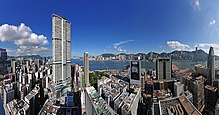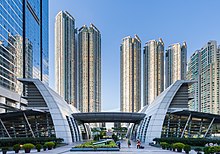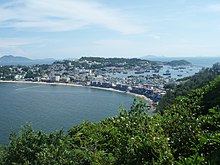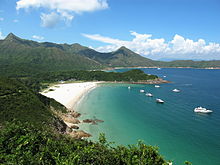Hong Kong
![]()
Hong Kong is a redirect to this article. For other meanings, see Hong Kong (disambiguation).
Template:Infobox State/Maintenance/NAME-German
Hong Kong, abbreviation: HK (Chinese 香港, Pinyin Xiānggǎng, Jyutping Hoeng1gong2, Yale Hēunggóng, English Hong Kong - "Fragrant Harbour", abbreviation: 港), is a metropolis and special administrative region on the southern coast of the People's Republic of China in the Pearl River estuary. With over seven million inhabitants on 1106 square kilometres and a significant economic and financial sector, Hong Kong is one of the world's cities. 95 percent of Hong Kong's inhabitants are of Chinese descent with a predominantly Cantonese mother tongue.
Hong Kong was occupied by the United Kingdom during the First Opium War in 1841 and declared a British Crown Colony by the Treaty of Nanking in 1843. For many Chinese, the British colony was a refuge from the Chinese Civil War of 1927 to 1949. In 1997, sovereignty was handed over to the People's Republic of China. Since then, Hong Kong has been a Chinese Special Administrative Region while maintaining a free market economy and a high degree of internal autonomy. This principle of one country, two systems was agreed by treaty in the Joint Declaration on Hong Kong. In the meantime, however, China has been accused of increasingly breaking this pledge, which has led to ongoing protests.
The most densely populated areas are the Kowloon Peninsula and the north of Hong Kong Island, separated by the narrow Victoria Harbour strait. The New Territories include the original hinterland north of Kowloon, which makes up the largest area of Hong Kong, and most of Hong Kong's 263 islands. Hong Kong's largest island is Lantau Island, which is also home to Hong Kong International Airport, on Chek Lap Kok Island.
The population growth and the small buildable area of Hong Kong led to large-scale land reclamation by filling in the sea and the emergence of a skyline of skyscrapers. After the construction of several planned cities in the second half of the 20th century, half of Hong Kong's inhabitants live in the New Territories.
Hong Kong is considered one of the cities with the highest cost of living in the world.
Designation
The name Hong Kong is derived from the Cantonese pronunciation [hœ́ːŋɡ̊ɔ̌ːŋ]. The official name is Hong Kong Special Administrative Region of the People's Republic of China (中華人民共和國香港特別行政區, Jyutping Zung1waa4 Jan4man4 Gung6wo4gwok3 Hoeng1gong2 Dak6bit6 Hang4zing3keoi1 ![]() , English Hong Kong Special Administrative Region of the People's Republic of China).
, English Hong Kong Special Administrative Region of the People's Republic of China).
Geography
Geographical position
Hong Kong is located at the mouth of the Pearl River into the South China Sea. The territory of Hong Kong extends over a very irregularly shaped peninsula and 263 islands, of which the most important are Lantau Island (147.2 km²), Hong Kong Island (78.6 km²), Chek Lap Kok (14.6 km²), Lamma Island (13.9 km²), Tsing Yi (10.7 km²), Cheung Chau (2.4 km²) and Peng Chau (1.2 km²). The territory is divided into Hong Kong Island, Kowloon, the New Territories and the Outlying Islands.
Of the 1104 km² land area, only about 25% is built-up. A substantial part of the built-up area was created by land reclamation in Victoria Harbour and the New Territories. Since 1887, 68 km² of land area have been added. This is mainly due to the very mountainous relief with many steep slopes; only in the north of the New Territories are there larger plains. The highest elevation is the Tai Mo Shan in the New Territories with 958 m. More famous is Victoria Peak, with 552 m the highest mountain on Hong Kong Island and a popular excursion destination. The 495 m high Lion Rock on the border between Kowloon and New Territories is considered one of the most striking natural monuments and Hong Kong's local mountain.

enlarge and show information about the picture
![]()
View from Kowloon Peak to Kowloon, behind Victoria Harbour and Hong Kong Island (2010)
Climate
| Monthly average temperatures and precipitation for Hong Kong
Source: WMO,www.wetter.de | ||||||||||||||||||||||||||||||||||||||||||||||||||||||||||||||||||||||||||||||||||||||||||||||||||||||||||||||||||||||||||||||||||||||||||||||||||||||||||||||||||||||||||||||||||||||||||||||||||||||||||||||||||||||||||||||
Hong Kong's climate is subtropical humid with an annual average temperature of 22.5 °C, rainfall of 2,382.7 mm and 10 humid months. Winter from January to March is mild to warm and dry, summer from April to September is hot and rainy, while autumn (October to December) is warm and dry. There is regular typhoon danger in summer; a typhoon on September 18, 1906, with a simultaneous tidal wave, cost the lives of about 10,000 people.
Urban Kowloon
View from Tsim Sha Tsui to Hong Kong Island (2013)
MTR Kowloon Station - Union Square, West Kowloon (2013)
Questions and Answers
Q: What is the population of Hong Kong?
A: The population of Hong Kong is over seven million.
Q: When did Britain handover control of Hong Kong to China?
A: Britain handed over control of Hong Kong to China in 1997.
Q: What is the other Special Administrative Region (SAR) of the People's Republic of China besides Hong Kong?
A: The other SAR of the People's Republic of China besides Hong Kong is Macau.
Q: How many outlying islands are part of New Territories in Hong Kong?
A: There are 235 outlying islands that are part of New Territories in Hong Kong.
Q: What was the status granted to Hong Kong by China after it was handed over in 1997?
A: After it was handed over in 1997, China promised to grant special status to Hong Kong for 50 years.
Q: When did British colonization begin in Hong Kong?
A: British colonization began in 1842 and lasted until 1997 when it was handed over to Chinese control under special status.
Q: How has the economy grown since World War II?
A: Since World War II, the economy has rapidly grown from a trading port into a very rich city with one of the highest costs of living and most skyscrapers in the world.
Search within the encyclopedia



